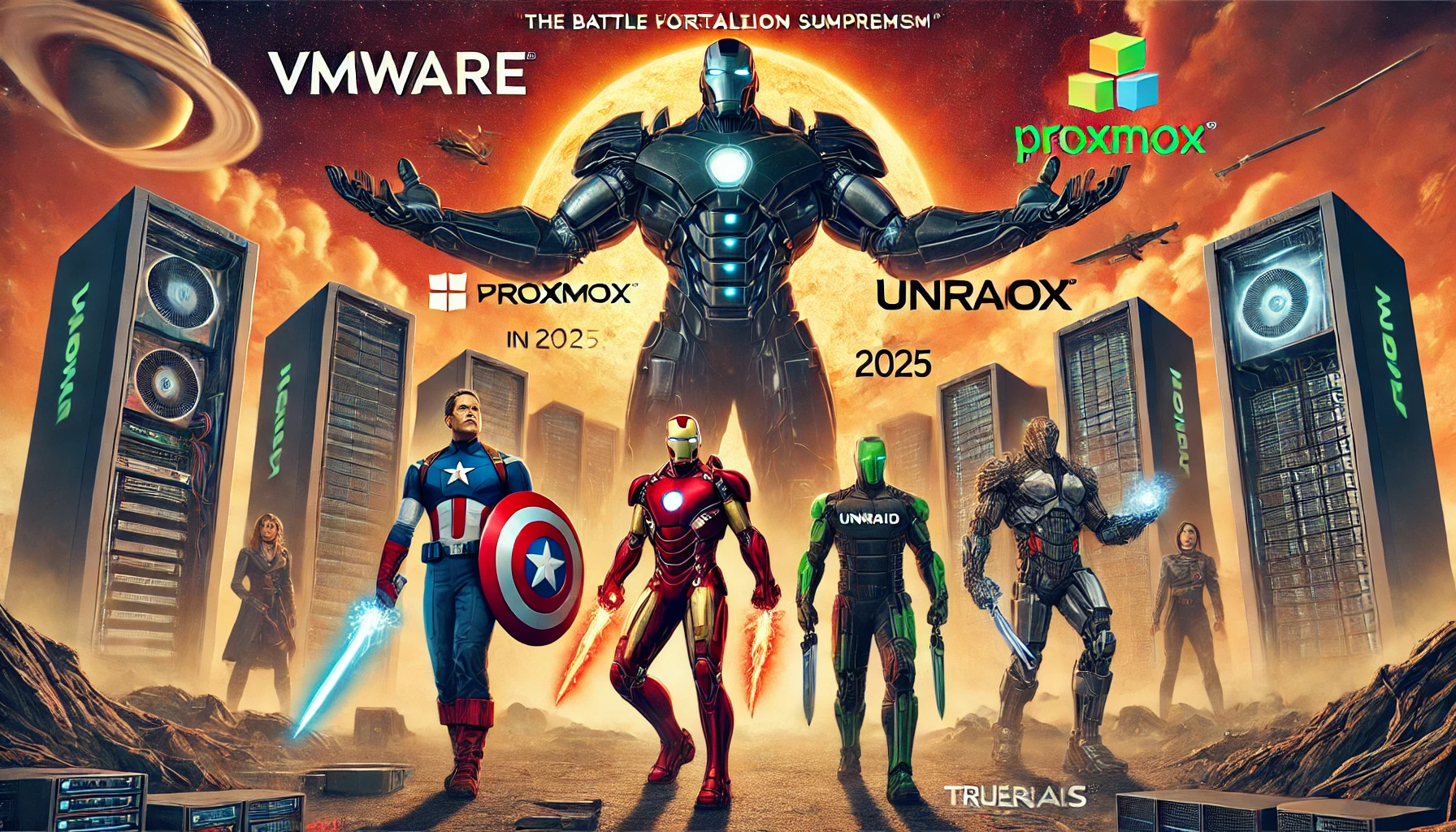In today’s data-driven world, virtualization platforms have become the backbone of modern IT infrastructure. Whether you’re managing a home lab, small business server, or enterprise data center, choosing the right virtualization solution can significantly impact performance, scalability, and overall return on investment. As we navigate through 2025, four major contenders continue to dominate the virtualization landscape: VMware, Proxmox, Unraid, and TrueNAS. Each platform brings unique strengths to the table, but which one will ultimately win the battle for virtualization supremacy? This comprehensive analysis dives deep into these competing technologies to help you make an informed decision for your specific needs.
Understanding the Virtualization Landscape in 2025
Virtualization technology has evolved dramatically over the past decade, moving from a specialized enterprise tool to an essential component of nearly every IT infrastructure. The ability to run multiple virtual systems on a single physical server has revolutionized resource utilization, disaster recovery, and deployment flexibility. As remote work and cloud technologies continue to expand, the demand for efficient, reliable virtualization platforms has never been higher.
The four platforms we’re examining approach virtualization from different angles, each with their own philosophy:
- VMware: The industry veteran focusing on enterprise-grade features and comprehensive management
- Proxmox: An open-source challenger emphasizing flexibility and cost-effectiveness
- Unraid: A storage-first solution that has expanded into virtualization
- TrueNAS: A robust storage platform that now offers virtualization capabilities
Before declaring a winner, we need to thoroughly understand what each platform brings to the table and how they compare across critical metrics that matter to users in 2025.
VMware: The Enterprise Standard
VMware has long been the gold standard in enterprise virtualization, offering a comprehensive suite of tools designed for large-scale deployments. The VMware ecosystem centers around ESXi (the hypervisor) and vCenter Server (the management platform), creating a powerful combination for businesses with complex virtualization needs.
Key Strengths of VMware
VMware’s primary advantage lies in its maturity and comprehensive feature set. The platform offers:
- Advanced networking capabilities with sophisticated configuration options
- Superior resource management with Dynamic Resource Scheduling (DRS)
- Industry-leading migration capabilities through vMotion technology
- Enterprise-grade security features with microsegmentation and encrypted VMs
- Integration with major cloud providers for hybrid cloud deployments
These capabilities make VMware particularly appealing for larger organizations that require maximum uptime, sophisticated management tools, and seamless scalability.
VMware Limitations
Despite its strengths, VMware faces significant challenges in 2025:
- Increased licensing costs following Broadcom’s acquisition, with the elimination of the free ESXi version
- Complex licensing structure that can be difficult to navigate
- Significant resource requirements for management components
- Steep learning curve compared to more user-friendly alternatives
As search result2 notes, “VMware is close-source and proprietary” with higher costs than alternatives like Proxmox, making it increasingly difficult to justify for smaller organizations with limited budgets.
Proxmox VE: The Open-Source Challenger
Proxmox Virtual Environment (Proxmox VE) has emerged as a formidable competitor to VMware, particularly for small and medium-sized businesses seeking a cost-effective virtualization solution. Based on Debian Linux, Proxmox combines KVM (Kernel-based Virtual Machine) for virtual machines and LXC (Linux Containers) for containerization.
Proxmox’s Competitive Edge
According to search result5, Proxmox offers several compelling advantages:
- Zero license cost with the open-source platform, providing full access to all functionalities
- User-friendly web interface for simplified management
- Integrated clustering without requiring a dedicated master node
- Support for multiple storage technologies including LVM, iSCSI, Ceph, ZFS, and more
- Complete feature set including high availability, firewall, and backup capabilities
A particularly notable strength is Proxmox’s flexibility in supporting various operating systems. Search result2 mentions: “Proxmox supports more operating systems than VMware does because of its KVM virtualization feature that is compatible with multiple operating systems which cover multiple Linux distributions, BSD operating systems, Windows OS, macOS, and Android.”
Proxmox Limitations
While Proxmox has gained significant traction, it does have some limitations:
- Less polished network setup that can be cumbersome compared to VMware
- Lower physical memory limits (12 TB maximum versus VMware’s 24 TB)
- Fewer hosts per cluster (32 maximum versus VMware’s 96)
- Less robust ecosystem of third-party integrations and tools
- Requires more technical knowledge for advanced configurations
Unraid: The Flexible Storage Virtualization Hybrid
Unraid takes a unique approach to virtualization by building on its strength as a network-attached storage (NAS) solution. This approach has made it particularly popular in the home lab and prosumer markets.
Unraid’s Unique Advantages
The latest Unraid OS 7.1.0, released in March 2025, brings several exciting features to the platform, as detailed in search result6:
- Flexible storage management allowing drives of different sizes in a single array
- Intuitive user interface that simplifies complex tasks
- Docker application support with easy management through the Community Apps plugin
- VM enhancements including VirGL for sharing GPUs across multiple Linux VMs
- Wireless networking support for greater deployment flexibility
- Foreign ZFS pool imports for easy migration from other platforms
As search result3 highlights, Unraid’s virtualization capabilities provide significant benefits: “Isolation – hardware virtualization enables you to run multiple operating systems and applications in isolated virtual environments on a single Unraid server. Each VM operates independently, ensuring that if one VM fails or is compromised, it doesn’t affect the others.”
Unraid Limitations
Despite its flexibility, Unraid does have some significant limitations:
- Limited RAID capabilities compared to traditional solutions (as the name suggests)
- Performance trade-offs with its unique parity system
- Not free (requires purchase of a license)
- Less optimized for large-scale virtualization compared to dedicated hypervisors
Search result4 specifically notes TrueNAS Scale’s advantages over Unraid: “TrueNAS Scale provides a more responsive experience when you wish to deploy multiple virtual machines and containers on your NAS.”
TrueNAS: Storage Excellence with Growing Virtualization Capabilities
TrueNAS (particularly TrueNAS Scale) represents a storage-first platform that has expanded into the virtualization space. Built around the robust ZFS file system, TrueNAS offers enterprise-grade storage features while increasingly competing in the virtualization arena.
TrueNAS’s Compelling Features
Search result4 highlights several advantages of TrueNAS Scale:
- Superior RAID provisions compared to solutions like Unraid
- Built-in iSCSI support which is particularly valuable for gaming and enterprise applications
- Free to use with no licensing costs
- Better performance in virtualization tasks and transfer speeds
- Robust data integrity through ZFS’s advanced features
TrueNAS Scale has particularly improved its virtualization capabilities, making it a more comprehensive platform than its Core predecessor.
TrueNAS Limitations
Despite these strengths, TrueNAS has some limitations as a primary virtualization platform:
- Storage-first design philosophy that may limit some virtualization use cases
- Less intuitive virtualization management compared to dedicated platforms
- Higher hardware requirements particularly for RAM, due to ZFS
- Expansion challenges when using ZFS storage
As search result7 notes: “TrueNAS is great at storage but if you want versatility Proxmox is a better option.”
Direct Feature Comparisons: Who Leads Where?
Now that we’ve examined each platform individually, let’s compare them across key criteria that matter most to users in 2025:
Storage Management
Leader: TrueNAS
When it comes to pure storage capabilities, TrueNAS clearly takes the lead with its ZFS implementation providing unmatched data integrity, snapshot capabilities, and performance. Search result7 confirms this assessment: “TrueNAS is primarily a NAS/SAN appliance, it excels at storage. It is the most widely deployed storage platform in the world.”
Unraid follows with its flexible approach to storage management, allowing drives of different sizes to be combined effectively. VMware and Proxmox, while competent, are primarily designed around virtualization rather than storage management.
Virtualization Performance
Leader: VMware (Enterprise), Proxmox (SMB/Home Lab)
For pure virtualization performance, VMware continues to lead in enterprise environments with its sophisticated resource management and optimization. As search result2 notes, VMware offers advantages like “boosted boot speed rate as it suspends the VM to the memory booting system and reduces downtime.”
For smaller environments, Proxmox provides excellent virtualization performance without the licensing overhead. Search result5 highlights that Proxmox VE supports up to “128 TiB [64 PiB] RAM, 8192 logical CPUs, 8 sockets” per host, making it capable of handling substantial workloads.
User Interface and Ease of Use
Leader: Unraid
For general usability, particularly for home users and those new to virtualization, Unraid offers the most intuitive experience. Its web-based interface simplifies complex tasks and provides a unified management environment for storage, applications, and virtual machines.
TrueNAS follows with its polished interface for storage management, while Proxmox offers a functional but less refined experience. VMware’s interface, while powerful, comes with a steeper learning curve.
Cost Effectiveness
Leader: Proxmox
When considering value for money, Proxmox stands out as the clear winner. As an open-source solution with no licensing costs for core functionality, it provides enterprise-grade features at a fraction of the cost of VMware. Search result17 states explicitly: “Proxmox is open source and free, eliminating the high licensing costs associated with VMware.”
TrueNAS also scores well in this category as a free platform, while Unraid requires a one-time license fee that remains reasonable for most users. VMware, especially after Broadcom’s acquisition, has become significantly more expensive, particularly for smaller organizations.
Community and Ecosystem
Leader: Mixed (Proxmox for community, VMware for commercial ecosystem)
The community support and ecosystem surrounding each platform varies significantly. VMware boasts the most extensive commercial ecosystem with numerous third-party integrations and professional support options. However, Proxmox has developed a vibrant open-source community that continues to grow, particularly as users seek alternatives to VMware.
Unraid has cultivated a passionate user base, particularly among home lab enthusiasts, while TrueNAS enjoys strong support in the storage community but less so for virtualization specifically.
Use Cases: Finding Your Perfect Match
Rather than declaring an overall winner, it’s more practical to identify which platform best suits different use cases:
Enterprise Data Centers
Recommendation: VMware
Despite its increasing costs, VMware remains the go-to solution for large enterprise environments where reliability, support, and advanced features justify the premium price. Its mature ecosystem, robust management tools, and enterprise-grade support make it the safest choice for critical business infrastructure.
Small to Medium Business
Recommendation: Proxmox
For SMBs seeking a balance of features, performance, and cost-effectiveness, Proxmox offers the most compelling package. As search result2 states, “Proxmox is best suited for personal/home use, running small applications as well as Small and Medium Businesses.” Its open-source nature provides significant cost savings while delivering enterprise-class features like high availability and clustering.
Home Lab / Enthusiast
Recommendation: Unraid or Proxmox
For home lab environments, both Unraid and Proxmox present excellent options depending on specific needs. Unraid excels when flexible storage management is a priority and ease of use is valued. The latest Unraid 7.1.0 release brings significant improvements to VM management, including features like VirGL for GPU sharing and improved VM templates, as highlighted in search result6.
Proxmox is ideal for home lab users who want to replicate enterprise environments or maximize virtualization capabilities without licensing costs.
Storage-First Requirements
Recommendation: TrueNAS
When storage reliability and performance are the primary concerns, with virtualization as a secondary requirement, TrueNAS stands out as the clear choice. Its robust ZFS implementation provides unmatched data protection, while TrueNAS Scale adds capable virtualization features. As search result7 notes, TrueNAS is “The Swiss Army Knife of the LAN” that excels at storage while providing additional functionality.
Performance Considerations: Hardware Requirements
A critical factor in choosing a virtualization platform is understanding its hardware requirements and how efficiently it utilizes resources:
Memory Usage
ZFS-based systems like TrueNAS have higher memory requirements due to the file system’s design, with a general recommendation of 8GB minimum and 1GB per TB of storage. VMware also tends to be memory-hungry, particularly when running vCenter Server.
Proxmox and Unraid can operate effectively with more modest memory allocations, making them suitable for environments with resource constraints.
CPU Requirements
All four platforms benefit from modern multi-core processors, but their utilization patterns differ:
- VMware makes excellent use of high core counts for enterprise workloads
- Proxmox efficiently distributes VM workloads across available cores
- Unraid allows specific CPU pinning as needed but as of version 7 can dynamically select cores
- TrueNAS benefits from additional cores primarily for ZFS calculations and compression
Storage Hardware Considerations
Storage requirements vary significantly:
- TrueNAS performs best with matched drives in proper RAID configurations
- Unraid shines with its ability to use mismatched drives with parity protection
- Proxmox and VMware are more flexible regarding storage hardware but benefit from dedicated arrangements for maximum performance
The Integration Question: Specialized vs. All-in-One
An interesting trend emerging in 2025 is the question of whether to use specialized platforms for specific functions or all-in-one solutions. Search result13 discusses the possibility of running TrueNAS on one machine and Proxmox on another, using the strengths of each platform. Alternatively, search result18 explores virtualizing TrueNAS within Proxmox to get the best of both worlds.
This reflects a broader debate in the virtualization community about separation of concerns versus convenience. For larger environments, separating storage and compute can provide better scalability and resource optimization. For smaller setups, an all-in-one approach may be more practical from both cost and management perspectives.
Future Outlook: Trends Shaping the Virtualization Battlefield
As we look beyond 2025, several trends are likely to influence which platform gains the upper hand:
Containerization Integration
The continued rise of container technologies like Kubernetes is reshaping how applications are deployed. Platforms that effectively bridge traditional VMs and containers will have an advantage. Both Proxmox (with LXC) and TrueNAS Scale (with its Kubernetes integration) are making strides in this area.
Hardware Acceleration and GPU Virtualization
With workloads increasingly requiring GPU acceleration, platforms with robust GPU virtualization support will gain favor. Unraid’s recent addition of VirGL for sharing GPUs across Linux VMs (search result6) demonstrates the growing importance of this feature.
Simplified Management and Automation
As IT environments grow more complex, the ability to automate and simplify management becomes crucial. VMware has traditionally led in this area, but Proxmox and others are rapidly improving their capabilities.
Licensing and Cost Pressures
Broadcom’s acquisition of VMware and subsequent licensing changes have prompted many organizations to consider alternatives. This trend is likely to continue, benefiting open-source solutions like Proxmox and free platforms like TrueNAS.
Making the Decision: A Framework for Choosing Your Platform
When deciding which virtualization platform is right for you, consider these key questions:
- What is your primary use case? (Storage, virtualization, or a balance of both)
- What is your budget? (Both initial and ongoing costs)
- What is your technical expertise level? (Some platforms require more knowledge than others)
- What are your scalability requirements? (How many VMs, how much storage, etc.)
- What existing infrastructure do you need to integrate with?
By answering these questions honestly, you can narrow down which platform best aligns with your specific needs.
Conclusion: Who Will Win the Virtualization Battle?
After thorough analysis, it’s clear that the “winner” in the virtualization battle depends entirely on your specific requirements and constraints. Rather than a single platform dominating across all scenarios, we’re seeing increased specialization and adoption based on use case:
- VMware will likely maintain its enterprise market share despite pricing pressures, particularly in large organizations with established VMware infrastructures.
- Proxmox is positioned to gain significant market share in the SMB space and among technical users seeking VMware alternatives without sacrificing features.
- Unraid will continue to dominate in the prosumer and home lab space, particularly for users who value flexibility and ease of use.
- TrueNAS will remain the go-to solution for storage-first environments, with its virtualization capabilities serving as a valuable add-on rather than its primary selling point.
The real winner in this battle may ultimately be the end-user, who now has multiple mature, capable platforms to choose from based on their specific needs. As these platforms continue to evolve and incorporate features from their competitors, the lines between them will blur further, leading to even more powerful and user-friendly virtualization options in the future.
Whether you’re building a home lab, managing a small business server, or running an enterprise data center, there’s never been a better time to implement virtualization technology. Each of these platforms offers a unique approach to solving common IT challenges, and by understanding their respective strengths and limitations, you can make an informed decision that will serve your needs well into the future.
What’s your experience with these virtualization platforms? Have you recently switched from one to another? Share your thoughts and join the conversation as we continue to explore the evolving landscape of virtualization technology.




